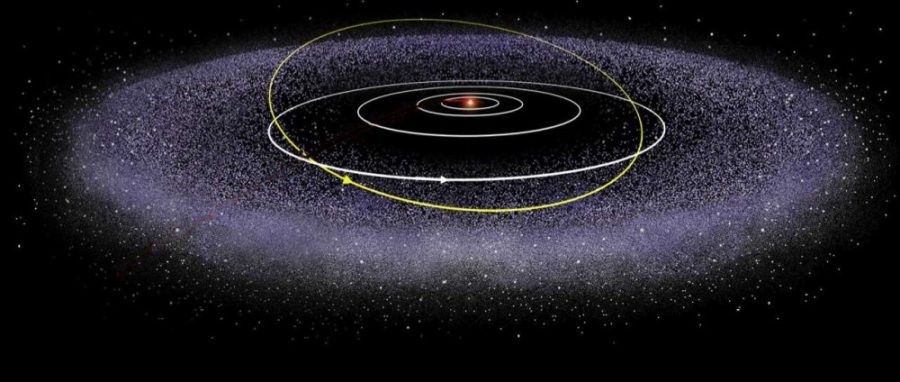
Disclaimer: Copyright infringement not intended.
Context
- Astronomers have found compelling evidence suggesting the existence of an Earth-like planet in the distant Kuiper Belt of our solar system, offering new insights into planetary formation and the potential for habitable environments beyond Earth.
Details
Introduction to the Kuiper Belt
- The Kuiper Belt is a region in our solar system that stretches from about 30 to 50 astronomical units (AU) from the Sun.
- One AU is the average distance from the Earth to the Sun, approximately 93 million miles (150 million kilometers).
- It is named after Dutch-American astronomer Gerard Kuiper, who first proposed the existence of this region in 1951.
Formation of the Kuiper Belt
The Kuiper Belt is believed to be a relic from the early days of our solar system. It is thought to contain remnants from the solar system's formation, making it a crucial area of study for astronomers and planetary scientists. Some key points about its formation include:
- After the formation of the Sun, a rotating disk of gas and dust surrounded it.
- Within this disk, small particles began to collide and stick together, forming planetesimals.
- Some of these planetesimals eventually grew into the planets, while others remained as smaller objects in the Kuiper Belt.

Composition of Kuiper Belt Objects (KBOs)
The Kuiper Belt is populated by a variety of objects, with different sizes and compositions. These objects are primarily composed of:
- Ices: KBOs are rich in volatile ices such as water, ammonia, and methane. These ices give them their distinctive appearance.
- Rock and Metal: KBOs also contain significant amounts of rock and metal, though these are often buried beneath the surface layers of ice.
- Organic Compounds: Some KBOs contain organic molecules, which are of great interest to scientists studying the origins of life.
Notable Kuiper Belt Objects
There are several notable objects within the Kuiper Belt, including:
- Pluto: Perhaps the most famous KBO, Pluto was once considered the ninth planet in our solar system but was reclassified as a dwarf planet in 2006.
- Eris: Another dwarf planet in the Kuiper Belt, Eris is similar in size to Pluto and played a role in redefining the criteria for classifying celestial bodies.
- Haumea, Makemake, and Quaoar: These are other notable dwarf planets in the Kuiper Belt.
- Ultima Thule (486958 Arrokoth): This is a KBO visited by NASA's New Horizons spacecraft in 2019, providing valuable data about the region.
Significance of the Kuiper Belt
The Kuiper Belt holds significant importance in our understanding of the solar system:
- Planetary Formation: It offers insights into the early stages of planetary formation and the materials present in the solar nebula.
- Dwarf Planets: The discovery of numerous dwarf planets in the Kuiper Belt has led to a reevaluation of how we categorize celestial bodies in our solar system.
- Origin of Comets: Many short-period comets originate in the Kuiper Belt, and studying these objects can help us understand the origins of cometary bodies and their composition.
Future Exploration Missions
Several missions have or are planned to explore the Kuiper Belt, including:
- New Horizons: This NASA spacecraft, launched in 2006, conducted a flyby of Pluto and continued its mission to explore the Kuiper Belt.
- Lucy: NASA's Lucy mission is set to launch in the future and will explore Jupiter's Trojan asteroids, which may have Kuiper Belt origins.
- OSIRIS-REx: While primarily a mission to study the asteroid Bennu, OSIRIS-REx will return a sample to Earth, providing insights into the early solar system.

Conclusion
In conclusion, the Kuiper Belt is a dynamic and scientifically important region of our solar system, shedding light on planetary formation, the origins of comets, and the diversity of celestial objects beyond Neptune. Ongoing and future missions promise to uncover more about this intriguing region and the mysteries it holds.
|
PRACTICE QUESTION
Q. Which of the following statements about the Kuiper Belt is correct?
- The Kuiper Belt is located between the orbits of Mars and Jupiter.
- It primarily consists of rocky asteroids.
- It is a region in the solar system beyond Neptune that contains icy objects.
Options:
A. Only Statement 1
B. Only Statement 2
C. Only Statement 3
D. Statements 1 and 3
Correct Answer: C)
|
https://newsable.asianetnews.com/world/unbelievable-scientists-uncover-evidence-of-earth-like-planet-in-our-solar-system-s-kuiper-belt-snt-s0ijgn





